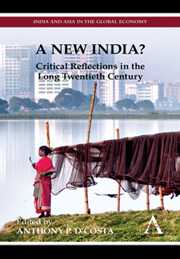Book contents
- Frontmatter
- Contents
- List of Tables and Figures
- Foreword by Deepak Nayyar
- Preface and Acknowledgements
- Chapter 1 What is this ‘New’ India? An Introduction
- Chapter 2 New Interpretations of India's Economic Growth in the Twentieth Century
- Chapter 3 Continuity and Change: Notes on Agriculture in ‘New India’
- Chapter 4 An Uneasy Coexistence: The New and the Old in Indian Industry and Services
- Chapter 5 Is the New India Bypassing Women? Gendered Implications of India's Growth
- Chapter 6 The ‘New’ Non-Residents of India: A Short History of the NRI
- Chapter 7 Revivalism, Modernism and Internationalism: Finding the Old in the New India
- Chapter 8 Creative Tensions: Contemporary Fine Art in the ‘New’ India
- List of Contributors
- Index
Chapter 7 - Revivalism, Modernism and Internationalism: Finding the Old in the New India
Published online by Cambridge University Press: 05 March 2012
- Frontmatter
- Contents
- List of Tables and Figures
- Foreword by Deepak Nayyar
- Preface and Acknowledgements
- Chapter 1 What is this ‘New’ India? An Introduction
- Chapter 2 New Interpretations of India's Economic Growth in the Twentieth Century
- Chapter 3 Continuity and Change: Notes on Agriculture in ‘New India’
- Chapter 4 An Uneasy Coexistence: The New and the Old in Indian Industry and Services
- Chapter 5 Is the New India Bypassing Women? Gendered Implications of India's Growth
- Chapter 6 The ‘New’ Non-Residents of India: A Short History of the NRI
- Chapter 7 Revivalism, Modernism and Internationalism: Finding the Old in the New India
- Chapter 8 Creative Tensions: Contemporary Fine Art in the ‘New’ India
- List of Contributors
- Index
Summary
[The 1959 Seminar on Architecture] will be able to supply the requirements of a new India, a free India, a democratic India which is aiming to be a Welfare State, an India which is aiming at reconciling differences and combining them into a unity. – H. Kabir
(Seminar on Architecture 1959, 4).The question of newness, of the production of a ‘new’ India or The New India, must consider the centrality of the ‘new’ within the context of architectural history. Art and architecture often comprise an attempt to create the avantgarde or the constantly and forever new, characteristic of northern Atlantic modernist art movements. In South Asia during the twentieth century, artists and architects struggled with the difficulty of balancing ‘Indianness’ and the new, engaging with the problem of absorbing and reacting to a hegemonic and ever-present European visual culture. Because the northern Atlantic appeared to have a lock on ‘the new’, South Asian expressions felt always behind, always derivative. The relation to the new was thus fraught with the simultaneous resistance to its putative source in Europe – a force carried along to India with modernization and Westernization.
Thus for architectural and artistic works, the question of a New India means grappling with a continual suspicion of and redefinition of the new after 1947. Kabir's epigraph above gives voice to the politicians' package of adjectives associated with the independent state and marks the need for their reassertion in the decades after independence: new, free, democratic.
- Type
- Chapter
- Information
- A New India?Critical Reflections in the Long Twentieth Century, pp. 151 - 178Publisher: Anthem PressPrint publication year: 2010



